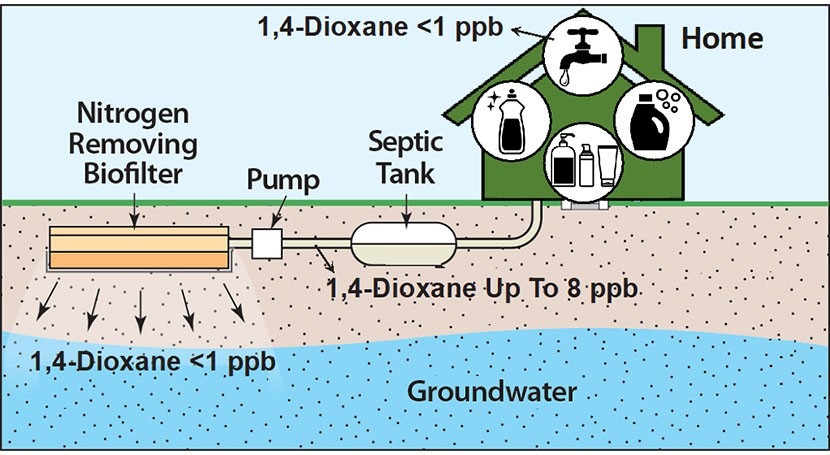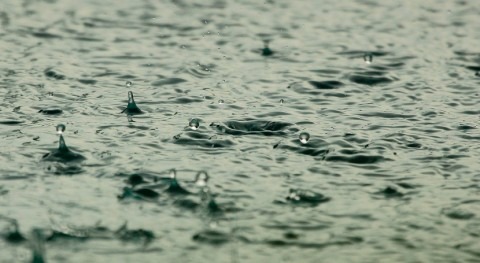The New York State Center for Clean Water Technology (CCWT) at Stony Brook University has made a series of critical discoveries regarding a new approach to protecting Long Island’s drinking water, groundwater, and surface waters. Some of the discoveries involve the likely human carcinogen, 1,4-dioxane, which has been found at higher levels in Long Island drinking water than anywhere else in the U.S.
The CCWT is advancing its novel technology for removing this chemical and other contaminants such as nitrogen before it enters groundwater. In addition, scientists affiliated with the Center have recently published research affirming household products as a likely source of 1,4-dioxane in wastewater.
According to Chris Gobler, PhD, Director of the CCWT, and Endowed Chair of Coastal Ecology and Conservation in the School of Marine and Atmospheric Sciences, 1,4-dioxane has been found at the highest levels ever measured in drinking water across the U.S. due to a large industrial plume. More recently, there has been the suggestion that beyond industrial contamination, 1,4-dioxane is also present at very high levels in common household products such as detergents, deodorants, and shampoos but evidence of this has been lacking.
Excessive nitrogen has shown to cause harmful algal blooms, the loss of important aquatic habitats like seagrass meadows, and the collapse of shellfisheries like clams and scallops; high nitrate in drinking water is also a public health concern. The Center has developed a series of innovative Nitrogen Removing Biofilters (NRBs) that is comprised of layers of natural products commonly found across Long Island, sand and woodchips.
In a new paper published in Ecological Engineering, scientists from the Center demonstrate that their NRBs installed in Massachusetts and New York remove up to 80 to 90 percent of nitrogen from wastewater before it is discharged to the ground.
“In 2015, we set a goal to develop a septic system that reduces nitrogen from wastewater to less than 10 milligrams of nitrogen per liter,” says Dr. Gobler. “With this publication, we are showing the word we have met that goal and can achieve nitrogen levels lower than any commercially available system.”
The Center is also focused on the ability of NRBs to remove other contaminants of concern, including 1,4 dioxane. Scientists are collecting samples from homes outfitted with NRB septic systems, specifically tap water, influent wastewater, which represents sewage from existing homes and entering NRBs, and effluent (treated wastewater) existing from NRBs before it enters the groundwater and Long Island’s drinking supply.
In another paper published in Science of the Total Environment, the Center demonstrated that while tap water samples have levels of 1,4-dioxane less than one part per billion (ppb), the drinking water standard for NYS levels of 1,4-dioxane in the wastewater leaving homes consistently contained levels higher than tap water levels, peaking as high as eight ppb and increasing more then 10-fold on average.
Importantly, the results also show that the treated wastewater exiting the NRBs were, on average, 56 percent lower levels than the wastewater leaving the homes and was usually less than one ppb.
“The efficient removal of 1,4-dioxane from wastewater by the NRBs is a breakthrough finding, as the chemical 1,4-dioxane is extremely difficult to remove from contaminated water supplies with advanced oxidation processes being one of the only reliable approaches,” summarizes Dr. Gobler.
“The results are surprising and at the same time encouraging as 1,4-dioxane is expected to resist natural degradation processes and are not removed efficiently by filtration,” says Arjun VenKatesan, PhD, Associate Director for Drinking Water Initiatives at the Center. “Our team is performing controlled experiments to understand the mechanism by which 1,4-dioxane is removed by NRBs.”
According to Drs. Gobler and Venkatesan, the results could also have broad implications for Long Island. The Center has collected more than 12 months of data as it completed the experimental testing phase of NRBs in septic systems in Suffolk County and have entered into a pilot testing phase of the systems across the county.





